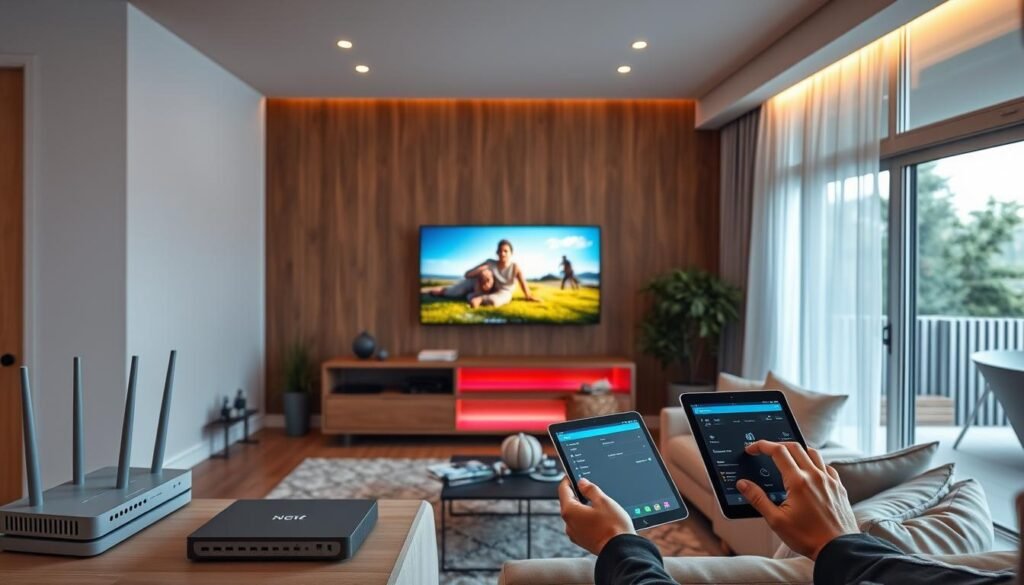Heading into 2025, IPTV streaming quality is more crucial than ever. Thanks to fast technology growth and higher viewer demands, high playback quality is key. This guide will show both casual viewers and tech fans how to keep their streaming smooth. It offers tips and tricks to avoid common issues. With the right approach, everyone can enjoy top-notch streaming that meets all their entertainment needs.
Key Takeaways
- IPTV streaming quality plays a crucial role in the viewing experience.
- Advancements in technology are reshaping viewer expectations.
- Optimal performance is key for both casual viewers and dedicated tech users.
- This guide offers strategies to improve playback quality.
- Understanding common pitfalls can enhance streaming performance.
Understanding IPTV Streaming Quality
IPTV stands for Internet Protocol Television. It delivers TV content via internet connections instead of traditional ways. This means viewers can stream a variety of channels and videos on demand. The flexibility of IPTV is making it increasingly popular.
What is IPTV?
IPTV streams through a network, allowing users to watch live TV and on-demand videos. It converts video signals into internet data. So, people can watch their favorite shows anywhere with an internet connection.
The Importance of Streaming Quality
Streaming quality is crucial for viewer happiness. High-quality streams offer clearer images and smooth playback. But, poor quality can cause buffering and interruptions. Steady streaming with IPTV is key, especially with good bandwidth. Choosing a service with fast content delivery is vital. For tips on finding the best IPTV service, see this guide.
Factors Affecting IPTV Streaming Quality
Several factors significantly influence IPTV streaming quality. To enjoy the best streaming, it’s key to understand these elements. They include bandwidth needs, network stability and latency, and whether your device works well with IPTV.
Bandwidth Requirements
Bandwidth is crucial for IPTV stream quality. High-definition shows need more bandwidth for a smooth view. You might need between 5-25 Mbps for clear pictures without breaks. Not having enough can cause freezing and mess up your watching fun. Before you start, check your bandwidth to dodge these problems. For tips on IPTV setup, see this guide.
Network Stability and Latency
A stable network matters a lot for IPTV. If your connection drops or slows, it could lead to lag. A strong, quick connection makes sure you don’t face delays. High latency means more loading time, ruining your viewing. A solid internet connection greatly improves your IPTV experience.
Device Compatibility
Your device needs to be right for IPTV for the best quality. Not all devices handle the same standards or high-definition. Compatible devices like Amazon Firestick, Android TV, and Smart TVs work best. Make sure your device matches IPTV specs for less trouble and clearer pictures.
Key Metrics for Assessing Streaming Quality
When you’re looking at IPTV streaming, several key metrics matter a lot. Understanding them can really help improve how much you enjoy your videos. The most important measures are the bitrate and resolution, but latency and buffering also have a big impact. On top of that, how good the fidelity and audio are really affects your streaming enjoyment.
Bitrate and Resolution
Bitrate is all about how much data gets processed every second in your stream. The higher the bitrate, the better your video will look, giving you more clarity and detail. Resolution is about the pixel count in your image. You might see terms like 720p, 1080p, and 4K, which all say something about the image quality. Finding the right balance is key to making content look good on any device.
Latency and Buffering
Latency is the time it takes from when you do something until you see it happen on-screen. High latency can really ruin the fun, causing delays between what you do and what you see. Buffering, which is when data loads too slowly and your video starts to stall, can also mess up your viewing. But if you have a good internet connection and the right streaming setup, these problems can be lessened.
Fidelity and Audio Quality
Fidelity is about how true the audio and video are to the original content. If the fidelity is high, it means your streaming experience is going to be much closer to what the creators intended. Don’t forget about audio quality either, because it’s super important. Good sound can make your streaming experience much better, letting you get totally lost in what you’re watching.
| Metric | Description | Impact on Streaming |
|---|---|---|
| Bitrate | Amount of data processed per second | Higher clarity and detail |
| Resolution | Pixel count that makes up a video | Varies visual fidelity (720p, 1080p, 4K) |
| Latency | Delay between user action and result | Affects responsiveness and experience |
| Buffering | Loading delay that interrupts playback | Can cause stutters and frustration |
| Fidelity | Accuracy of audio and video reproduction | Enhances immersion and enjoyment |
| Audio Quality | Clarity and richness of sound | Crucial for overall engagement |
Optimizing Your Home Network for IPTV
Making your home network better can make your IPTV streaming much smoother. Things like router settings, the way you’re connected, and QoS adjustments are key. By looking into these, you can reduce delays and avoid buffering, making everything more enjoyable.
Router Settings for Optimal Performance
Making the right changes to your router settings is very important. You should pay attention to:
- Channel Selection: Pick channels that are not too crowded to lessen interference from other networks nearby.
- Frequency Band Usage: Use the 5GHz band to get faster speeds with less interference, which is great for streaming.
- Firmware Updates: Regularly update your router’s firmware to maintain the best security and performance.
Wired vs. Wireless Connections
The choice between wired and wireless connections can impact your IPTV watching experience. Consider the following points:
| Connection Type | Advantages | Disadvantages |
|---|---|---|
| Wired |
|
|
| Wireless |
|
|
Quality of Service (QoS) Configurations
Using QoS setups can help make IPTV a priority over other internet uses. This is great for when your video content needs more bandwidth. Just adjust your router’s QoS settings to prioritize IPTV. This helps avoid problems when many applications are used at once.

Choosing the Right IPTV Service Provider
Choosing the right IPTV service is key to enjoying your streaming. It’s important to look at several things to decide wisely. This includes the variety of channels, cost, how well it works with your devices, and extra features.
Evaluating Service Options
It’s crucial to check the content variety and quality from IPTV providers. Those with lots of live channels and VOD tend to be better. Also, pricing can differ a lot, so it’s important to know what you get for your money. Reading reviews on Trustpilot helps understand what others think of them.
Customer Support and Reliability
Good customer support is very important. It helps when you have technical problems. Look for providers who respond quickly and solve issues well. Checking their support methods, like chat, phone, and email, is a good idea. Feedback from users can tell you a lot about how reliable the service is.
IPTV Streaming Quality 2025: Future Trends
By 2025, we can expect major boosts in IPTV streaming quality, thanks to new tech breakthroughs. The fast pace of this industry’s growth matches up with what viewers want and tech upgrades. Here, we’ll dive into upcoming breakthroughs and how 5G technology will make a big difference.
Advancements in Streaming Technology
Today’s tech developments are all about making streaming better for users and delivering content more efficiently. Important focus areas include:
- Advanced Compression Techniques: With these, we can enjoy high-quality streams without using too much bandwidth. This makes streaming easier for everyone.
- Artificial Intelligence Integration: AI will help make sure we get movie and show recommendations that fit our likes, making services run more smoothly.
- Adaptive Bitrate Streaming: This smart tech adjusts video quality based on your internet speed. This way, videos play smoothly, with less buffering.
The Role of 5G in IPTV
The entry of 5G into IPTV will change the game. It offers faster speeds and less delay, which will reinvent how we watch TV and movies online. The benefits we’re looking forward to include:
- Enhanced Streaming Quality: Expect smoother streams with fewer stops and starts.
- Faster Load Times: Quick content loading makes watching shows more enjoyable and might even keep us watching longer.
- Support for Higher Resolutions: Thanks to 5G, streaming in 4K or even higher quality will become easier. This meets viewers’ growing demand for crystal-clear pictures.

To wrap up, the blend of cutting-edge streaming tech and fast 5G rollout points to a bright future for IPTV. These improvements will change the way we get our digital entertainment.
Enhancing Playback Quality with Smart Devices
To boost your IPTV enjoyment, smart devices are key. They support the best streaming quality and work with many apps to improve viewing. With the right device set up correctly, watching movies or series gets better.
Recommended Devices for Optimal Streaming
Choosing top-notch technology is vital for the best streaming experience. Here are some top smart devices:
| Device | Streaming Capability | Features |
|---|---|---|
| Roku Streaming Stick 4K | 4K HDR | Voice remote, thousands of channels |
| Amazon Fire TV Cube | 4K UHD | Hands-free Alexa control, Dolby Vision |
| Apple TV 4K | 4K HDR | Seamless integration with Apple ecosystem |
App Settings and Configurations
Tweaking app settings is crucial for better streaming. Change settings to suit your internet speed and preferred quality:
- Set the video resolution to match your device capability.
- Enable hardware acceleration to improve playback performance.
- Adjust buffering settings to reduce interruptions.
Regular Updates and Maintenance
Updating smart devices is essential for top performance and safety. Frequent firmware updates boost app features and fix problems. Always check for updates to enjoy smooth streaming.
Content Delivery Networks and Their Impact
Content Delivery Networks (CDNs) are crucial for better IPTV streaming. They help service providers improve the streaming experience. CDNs use many servers in different places. This reduces latency and boosts performance.
Understanding CDNs in IPTV Streaming
Content delivery networks focus on distributing content well. They spread content over several servers to shorten the data travel distance. This helps with faster starts and better stream quality, especially for large video files.
The Role of Local Nodes
Local nodes are key for CDNs’ success. Placed near users, they ensure quick content access. Their close location means fewer interruptions and smoother streaming. This way, users get a seamless viewing experience thanks to faster data transfer.

| Aspect | Description | Benefits |
|---|---|---|
| Latency | Time delay in data transfer between the server and the user. | Lower latency leads to smoother playback. |
| Load Time | Time taken for video content to start playing. | Quicker load times enhance user satisfaction. |
| Redundancy | Backup servers to prevent content loss. | Ensures continuous streaming during outages. |
In summary, CDNs greatly improve IPTV streaming. Thanks to local nodes, viewers enjoy faster load times and stable streaming.
Troubleshooting Common IPTV Streaming Issues
IPTV viewers often face streaming problems that ruin their enjoyment. It’s vital to know why these issues happen for better IPTV troubleshooting. We’ll look at common issues like buffering and audio sync problems, and how to fix them.
Buffering Problems and Solutions
Buffering is a common annoyance for IPTV viewers. It usually happens when there’s not enough bandwidth, the network is too busy, or the device can’t cope. By following these tips, you can improve your streaming:
- Increase bandwidth: Make sure your internet speed is fast enough for streaming.
- Optimize network settings: Tweak your router’s settings to make streaming a priority.
- Upgrade devices: Use newer devices that better support high-quality videos.
- Reduce network usage: Stream with fewer devices using the internet to free up bandwidth.
Audio/Video Sync Issues
When the audio and video don’t match, it can be annoying. This can be due to bad cables or old software. Here are ways to fix audio sync issues:
- Check connections: Make sure all cables are plugged in properly and work well.
- Adjust device settings: Look at your app or device’s audio settings to match audio with video.
- Update software: Keep your IPTV app and device updated for the best performance.
Dealing with these issues directly helps viewers enjoy smooth streaming. This minimizes disruptions from buffering and audio sync issues.
| Issue | Common Causes | Recommended Solutions |
|---|---|---|
| Buffering | Insufficient bandwidth, network congestion | Increase bandwidth, optimize network settings |
| Audio Sync | Faulty connections, outdated software | Check connections, update software |
Conclusion
Understanding how to make IPTV streaming better is key for enjoying shows more. Looking at factors like how much internet speed is needed, keeping a stable internet connection, and making sure devices work well together helps a lot. Following tips from this guide on setting up your network, picking a good IPTV service, and using the right devices can greatly improve streaming.
It’s important for viewers to check their current settings and be open to changing them. Doing something as simple as adjusting router settings or checking if your devices work well with IPTV can make a big difference. Consider trying out service providers like WatchMax TV, who offer help and free trials to get the best streaming quality.
Making IPTV streaming better is a must-do for today’s viewers. As technology gets better, being aware and choosing wisely will let you enjoy your favorite shows even more. Keep these ideas in mind and make your IPTV streaming experience better today!
FAQ
What is IPTV and how does it work?
IPTV means Internet Protocol Television. It streams TV content over the internet. This lets viewers watch shows and movies directly online, without traditional cable or satellite.
Why is streaming quality important?
Good streaming quality is key for enjoying videos. It ensures the video and audio are clear and smooth. Speed and resolution matter for the best experience.
What factors can affect my IPTV streaming quality?
Many things can impact streaming, like how much bandwidth you have, network stability, and if your device works well with IPTV. Low bandwidth may cause delays, and a poor network might interrupt your show.
What metrics should I consider when assessing streaming quality?
Look at bitrate, resolution, how fast it plays, and audio quality. These help figure out if your IPTV is working well. They affect how much you’ll like watching.
How can I optimize my home network for IPTV streaming?
Improve your network by changing router settings for the better. Use cables instead of Wi-Fi for a steadier connection. Set your router to favor IPTV traffic. This will make streaming smoother.
What should I look for when choosing an IPTV service provider?
Check the variety of shows, cost, what other users say, and if help is available when needed. A reliable provider makes watching hassle-free and provides good support.
What future trends in IPTV streaming should I be aware of?
Look out for smarter streaming technology and better ways to compress videos. 5G will make streaming faster with less waiting. This means better quality viewing is on the horizon.
How can I enhance my playback quality on smart devices?
Pick devices that allow high-quality viewing. Tweak app settings for peak performance. Keep your device’s software updated for the best quality and security.
What are content delivery networks (CDNs), and how do they impact IPTV?
CDNs spread content across the internet efficiently. They lower wait times and make streaming faster by using closer servers. This gives a better and more reliable viewing experience.
How do I troubleshoot common IPTV streaming issues?
Fix buffering by adjusting your network, increasing bandwidth, or using a newer device. For sync issues, check your settings and connections to make sure they’re correct.




